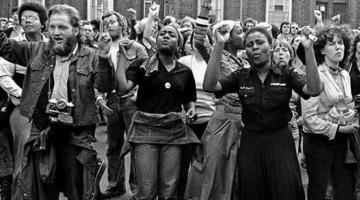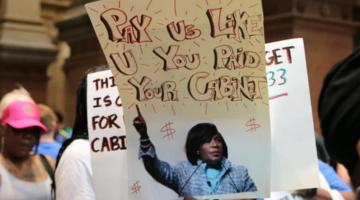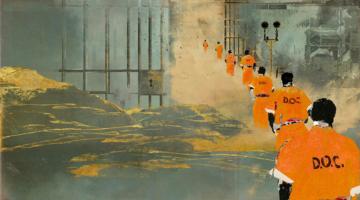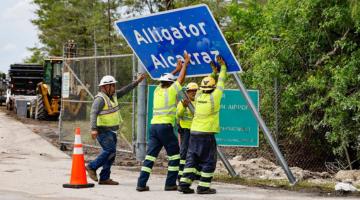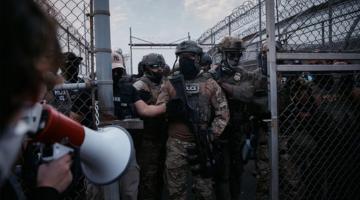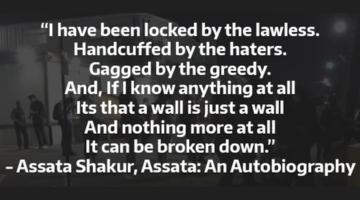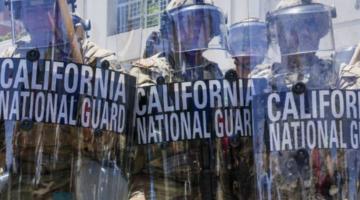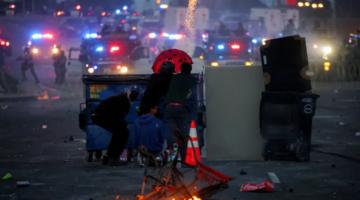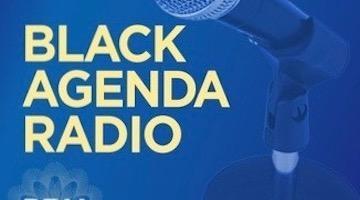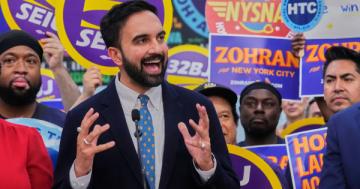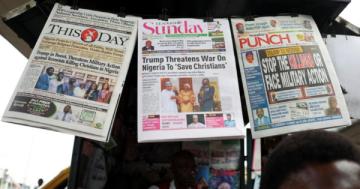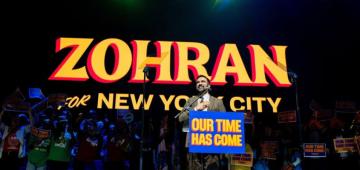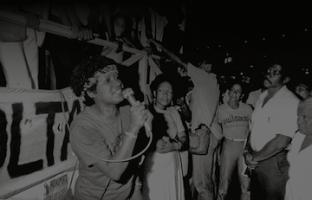The Dali trapped in the wreck of the Key Bridge.
The deaths of the six Latino immigrant workers in the Baltimore bridge collapse encapsulates the injustice inherent in the U.S. capitalist system.
Originally published in Struggle La Lucha.
Baltimore — In the very early morning hours of March 26, while it was still dark and most people were asleep, the massive 984-foot-long, 213-million-pound container ship Dali lost power, veered off course and struck one of the main concrete supports of the Francis Scott Key Bridge. Within minutes, the bridge collapsed.
Shock and disbelief were immediate. Fear and grief followed rapidly.
Word spread quickly in Turner Station, the neighborhood closest to the Key Bridge. Oliver Baptist Church immediately called a prayer vigil for the lives of the immigrant workers from Honduras, Guatemala, El Salvador, and Mexico who were laboring on the bridge at the time of its collapse.
Families in this tight-knit community hugged each other, deeply aware that many of their own members traverse the bridge daily.
Turner Station is a historic Black community. The town grew out of a need for Black millworkers to have a place to live while nearby Dundalk remained segregated.
During the “Great Migration,” people came to get jobs at Bethlehem Steel. But with deindustrialization and the closing of the mill, the area is now an industrial “Brownfield” — much of it abandoned or underutilized due to industrial pollution.
A giant Amazon warehouse complex, which employs thousands of overworked and underpaid workers, stands in place of the once-unionized Bethlehem Steel. The bridge could be seen in the near distance.
War on immigrants
Six immigrant workers died in the bridge collapse, changing the lives of their families and communities.
When the ship hit, eight workers employed by Brawner Builders were fixing potholes on the bridge. All were Latino immigrants from ages 26 to 49. Only two survived. One worker from Michoacán, Mexico, was hospitalized and is recovering from injuries.
All had partners and families who were part of the immigrant communities in Southeast Baltimore and Dundalk. The surviving families are dependent on the incomes of these workers, who perform difficult and dangerous work.
The bodies of two workers were recovered from the freezing waters. Divers found both trapped inside a red pickup truck on March 27. They were identified as Alejandro Hernandez Fuentes, 35, from Veracruz, Mexico, and Dorlian Ronial Castillo Cabrera, 26, from San Luis, Guatemala.
Road crews, made up of primarily immigrant workers, perform dangerous, mostly low-wage, non-union work in unsafe conditions. Less than a year ago, six immigrant workers lost their lives on Interstate 695, the Baltimore Beltway, when one of two speeding cars crossing between barriers struck and instantly killed them.
The violent deaths of these workers illustrate the hypocrisy of the vicious war on immigrants that has been perpetrated by both capitalist parties, Republicans and Democrats. The same workers whose bosses depend on them to do the dirtiest and most dangerous work are vilified as criminals and scapegoated.
Gateway to Baltimore’s port
The 47-year-old Key Bridge, named after a slaveholder, is the gateway to Baltimore’s main port – the deepest harbor in Maryland’s Chesapeake Bay. Ships had to pass beneath it to enter or exit the port. Baltimore is also the closest East Coast port to the Midwest.
In addition, the bridge was a major artery for road traffic, linking Interstate 695 across a 1.6-mile-long span of the Patapsco River. In 2023, approximately 12.1 million vehicles – roughly 33,000 daily – drove across the Key Bridge.
Currently, the port is shut down; ships cannot leave or enter until salvage and debris blocking the 50-foot-deep shipping channel are removed. There are no clear estimates on how long it will take to open the channel or build a new bridge. Reports differ wildly, ranging from 3 to 15 years.
It’s estimated that 15,000 people work directly at the Baltimore Port, and 140,000 jobs are indirectly tied to it. All will be impacted by the shutdown.
Thousands of trucks must find new routes. Cargo ships have been turned away from Baltimore to other ports, disrupting the flow of goods from container ships to final destinations. The environmental impact has yet to be determined.
A confusing network of quasi-public agencies administers the Baltimore Port, but private shipping companies actually rule the roost. Their profit drive prevents them from acting in any manner that can be characterized as rational, much less in the interests of the people.
A preventable disaster
What happened at the Key Bridge could have been expected and should have been prevented.
U.S. Transportation Secretary Pete Buttigieg quickly claimed that the collision and collapse were a unique, one-in-a-million-chance accident. The ship was so large that nothing could have prevented the collapse once it hit the main concrete support.
But engineers indirectly dispute Buttigieg, citing a lack of protection systems that are already in use, especially in busy shipping channels where large ships come and go frequently. They describe the different mechanisms to protect bridges, comparing them to a bumper system.
For example, more than 40 years ago, the Sunshine Skyway over Lower Tampa Bay, Florida, collapsed when the freighter Summit Venture collided with its support beam. Thirty-five people were killed.
Afterward, a new bridge was built with an extensive system of protections.
Giant ships for giant profits
Of course, what Buttigieg says is true on the surface: that a ship the size of the Dali striking the bridge’s main support would cause its collapse. But it immediately raises the question of oversized ships safely traversing waterways. Why do outsized cargo ships even exist?
The answer is that shipping companies need to maximize profits.
Worldwide, cargo ships have gotten bigger, and with increased automation and technology, crews have gotten smaller. Containerization is the longshore component of this process.
The oversized Dali, described as being as tall as the Eiffel Tower, was staffed by a crew of just 22 workers. Maersk, one of the world’s largest shipping companies, chartered it, which reported more than $51 billion in revenue in 2023.
Earlier, a Maersk whistleblower was disciplined and then fired after reporting inoperable lifeboats, unpermitted alcohol consumption, faulty emergency fire equipment, and other concerns aboard a Maersk-operated ship to the federal government. As a result, Maersk was sanctioned by the U.S. Labor Department eight months prior to the crash.
Workers at the Baltimore Port have questioned why tug boats were not assigned to the Dali. The answer is obvious – it costs money and cuts into profits.
Decaying U.S. infrastructure
Of 35 reported major bridge collapses around the world, at least 18 have been in the U.S. – a damning statistic. Three of those were in Maryland.
In its four-year report card, the American Society of Civil Engineers (ASCE) states that 46,154 U.S. bridges are in “poor” condition. At least 178 million trips are taken across these bridges each day.
The ASCE states that to improve the conditions of bridges nationally, spending must be increased from $12.4 billion to $22.7 billion annually.
The cost may seem high to the average worker trying to make ends meet. But compared to the $886 billion military budget passed in 2024, it’s peanuts.
That astronomic military budget does not even include the nearly $4 billion worth of arms Washington gives to Israel annually. Those weapons are now being used to commit genocide in Gaza. The Biden administration wants to send the racist settler state $14 billion more this year.
Gary Wilson, writing for Struggle-La Lucha, points out: “Biden’s federal budget, signed on March 24, exposes the chilling reality of U.S. imperialism: Even as its economic power fades, its pursuit of global domination grows. A staggering 68% of official federal spending – $1.1 trillion – fuels war and repression. But the reality is potentially double that amount, according to independent researchers.”
What’s next for workers?
The most immediate question is the loss of income for the estimated 15,000 workers who have lost paychecks. The 2,400 longshore workers who belong to International Longshoremen’s Association Local 333 are on the front lines.
These workers are hired daily, so there is no work for them when there are no ships or cargo to load and unload. Scott Cowan, president of ILA 333, expressed how dire the situation is for workers concerned about mortgages, rent, and bills.
There is a level of uncertainty not only for these workers but also for those who work at small restaurants and convenience stores in the area and in other port jobs.
Alec Summerfield, pro bono attorney for the Unemployed Workers Union and the Peoples Power Assembly, explained: “All impacted workers need direct pay similar to the federal unemployment pandemic benefits (PUI). Maryland cannot handle this alone. The union cannot do it alone.”
He added that there needs to be a comprehensive relief program, including a halt on mortgage foreclosures, evictions, and repossessions during the rebuilding, and the government must protect people from price gouging.
Sharon Black is a former Amazon worker. She worked in the warehouse complex in the shadow of the Key Bridge.

